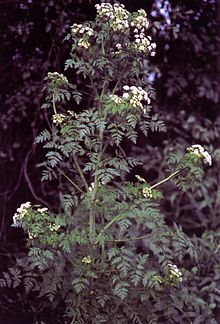Poison hemlock
| Conium maculatum | |
|---|---|
 |
|
| Conium maculatum in California | |
| Scientific classification | |
| Kingdom: | Plantae |
| (unranked): | Angiosperms |
| (unranked): | Eudicots |
| (unranked): | Asterids |
| Order: | Apiales |
| Family: | Apiaceae |
| Subfamily: | Apioideae |
| Genus: | Conium |
| Species: | C. maculatum |
| Binomial name | |
|
Conium maculatum (L., 1753) |
|
| Synonyms | |
|
List
|
|
Conium maculatum (hemlock or poison hemlock) is a highly poisonous biennial plant herbaceous flowering plant in the carrot family Apiaceae, native to Europe and North Africa.
Conium maculatum is known by several common names. In addition to the English poison hemlock, the Australian Carrot Fern, and the Irish devil's bread or devil's porridge, poison parsley, spotted corobane, and spotted hemlock are used. The plant should not be confused with the coniferous tree Tsuga, also known by the common name hemlock even though the two plants are quite different. The dried stems are sometimes called kecksies or kex.
Conium comes from the Greek konas (meaning to whirl), in reference to vertigo, one of the symptoms of ingesting the plant.
Conium maculatum (hemlock, poison hemlock) is a herbaceous biennial flowering plant in Apiaceae, the carrot family, that is native to Europe and North Africa. It grows to 1.5–2.5 m (5–8 ft) tall, with a smooth, green, hollow stem, usually spotted or streaked with red or purple on the lower half of the stem. All parts of the plant are hairless (glabrous); the leaves are two- to four-pinnate, finely divided and lacy, overall triangular in shape, up to 50 cm (20 in) long and 40 cm (16 in) broad. The flowers are small, white, clustered in umbels up to 10–15 cm (4–6 in) across. When crushed, the leaves and root emit a rank, unpleasant odor often compared to that of parsnips. It produces a large number of seeds that allow the plant to form thick stands in modified soils.
...
Wikipedia
